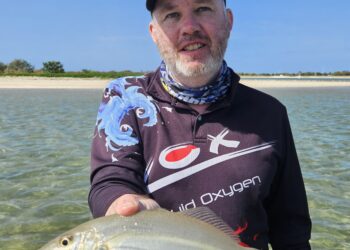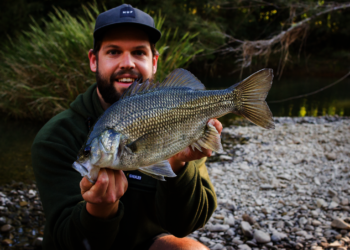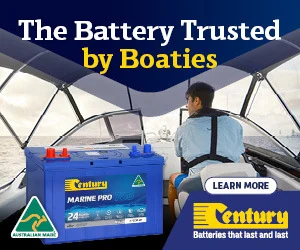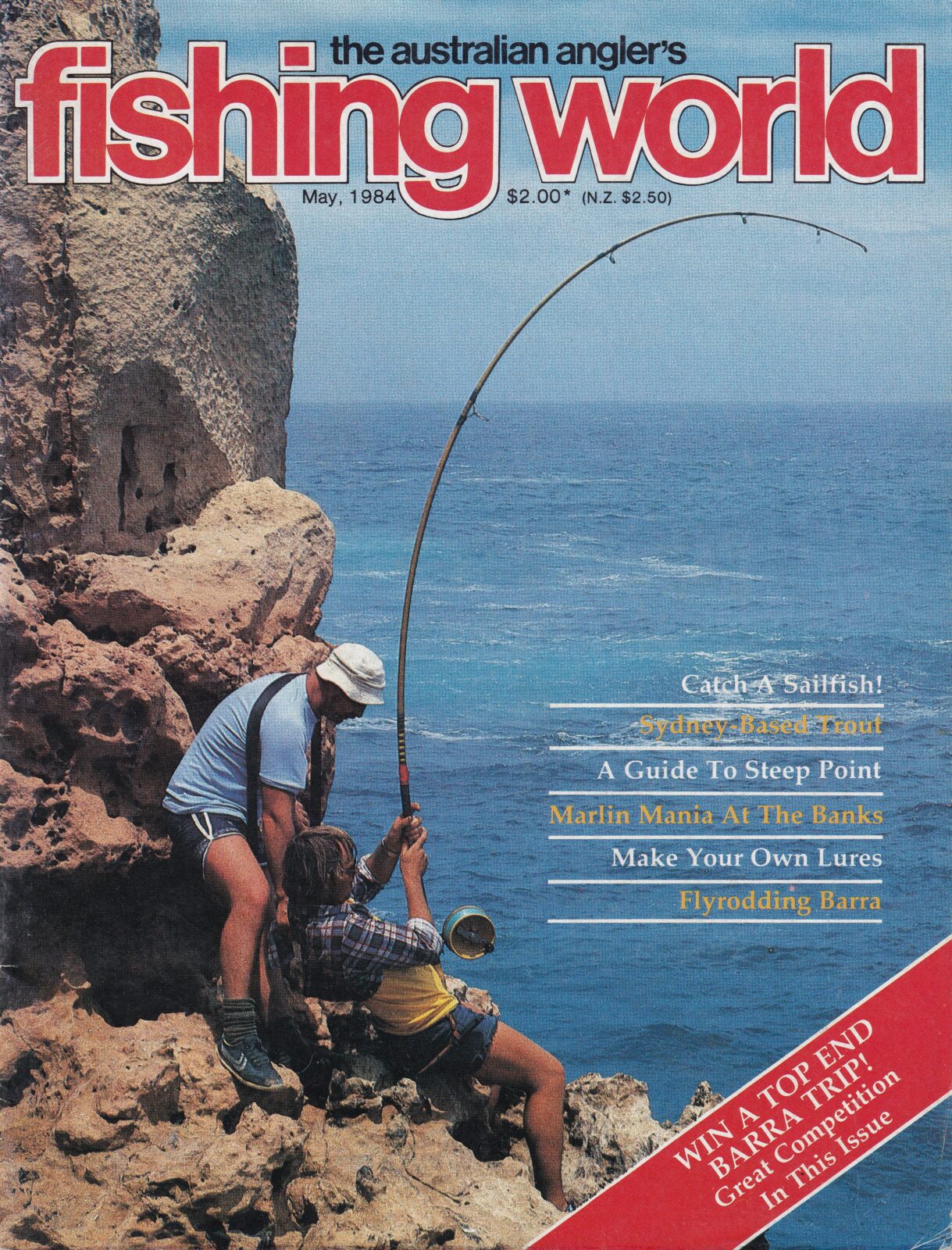
The following story was originally published in the May 1984 edition of Fishing World.
Arthur Drage grabbed a firm handful of the young angler’s shirt to give him support as he leaned into an unseen heavyweight off Steep Point.
I peered through the camera’s viewfinder at the action and mentally added a new dimension to a time-worn phrase: “You can’t go any further west than that, young man. .”
On reflection it was more a statement than a phrase – that angler was stretching his back muscles hard up against the most westerly rock in Australia.
Not even Danish adventurer Hans Tholstrup could have travelled that far west when he drove across the continent from its most easterly to its most westerly point – from Cape Byron to Steep Point. I imagine Hans would have parked his vehicle down near the lighthouse and walked out to the rocks where this dogged angler was now battling what was obviously a big shark.
As so often happens, he never saw what he was fighting… the fish eventually broke off, making life easier for the angler and his patient anchorman.
It was my second trip out to Steep Point during three visits to the Shark Bay area in recent years.
This time I was with Tony Howson, his son Clayton and my son Nick. We were in Tony’s 4WD Bedford van, which boasts a V8 engine but which is called, somewhat disparagingly, the Baker’s Van by most of Tony’s mates. We were also towing a trailer with a 12 foot tinny atop and we certainly had our moments trying to haul that lot up some awesome sand hills on the trip home. But more of that later.
Trying to evaluate Steep Point as a land-based game hotspot has provided me with problems which, I suppose, are all of my own making. Stock phrases . . . labels . . . spring to mind: “WA’s latest land-based gamemecca…”
“It was Cuvier in the 70s, now it’s Steep Point in the 80s…”
The comparison with Cuvier is obvious and screams out to be made, especially when you have a treasurehouse of memories like mine.
The first time . . . the only time in my life I savoured the two dawns at the same moment. One was real and the other was the dawn of a new era of excitement.
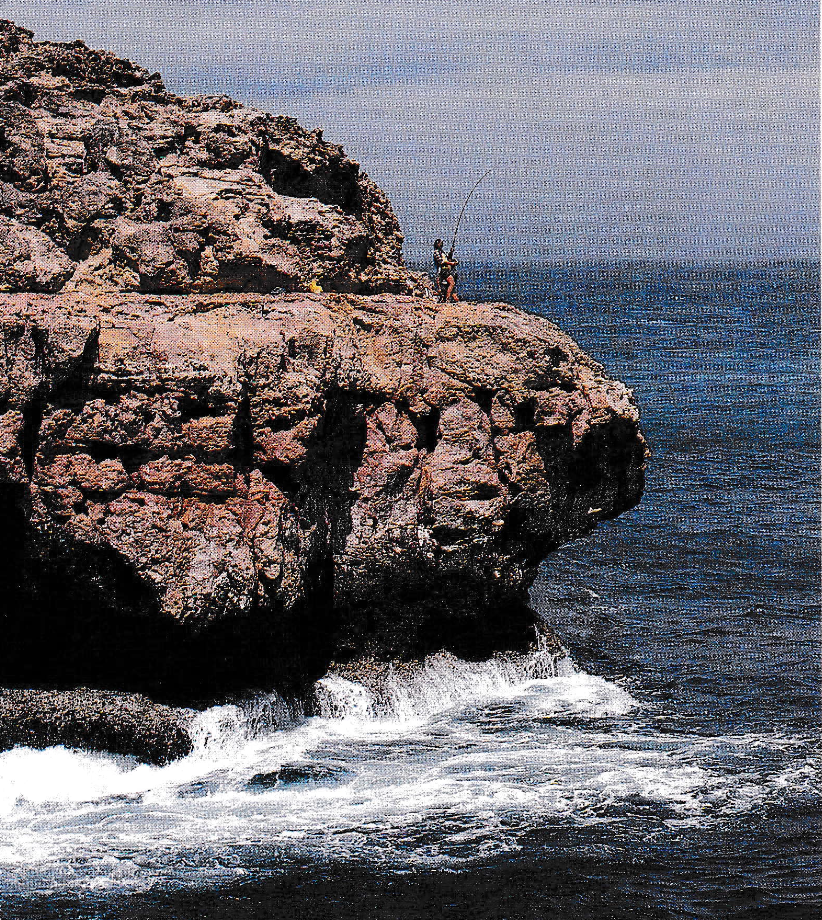
Standing on THE rock with the little man whose name it bore from that day on .
“lt looks like being a good day on a mulie,” said Garthie quietly. I trolled the mulie in slowly as Max stripped in a Deceiver and a huge trevally emerged from the depths and lunged at the fly. Then it saw my mulie, flashed ten yards across and engulfed it, and suddenly I was playing a bucking, bruising 24 pound gold-spot trevally – a sportfish I had only read about.
Memories . . . a slashing, chopping school of northern blues moved in and the real thrills started. My tuna strike came on a WK Arrow and the fish took off on a sizzling run in a wide, sweeping arc. lt was only lip-hooked and its speed was incredible.
Memories . . . soon there were shark mackerel and narrow-banded Spaniards everywhere and we all had strikes and hookups on lures and jigs . . . there was a queue for gaffing and it was what we had driven 700 miles for.
Memories .. . at one stage there was a breath-taking lineup of sea creatures right in front of us: A vast manta ray flapped lazily, three or four big cobia finned on the surface, and a 10 to 12 foot bronzie cruised around only ten yards from them.
Memories…All that happened during a landmark first visit to Cuvier in June ’73 – so perhaps it’s understandable that I should be looking for something special a decade later at another LBG area said by some to be just as good as the Cape and Quobba.
But comparisons can be odious as well as obvious, so let’s just look at Steep Point in its own right – at what it has going for and against it.
The first big plus is that the bite there can be just as hot as anywhere else iI you’re there at the right time. The area is blessed with an impressive mix of temperate and northern species: Huge tailor, whopper narrow-bar Spaniards, shark macks to seven kilos, cobia, sails, sea kings, (Samsons) yellowtail kings and amberjacks (yes, all three), pink snapper and nor-westers (spangled emperor) and monster sharks.
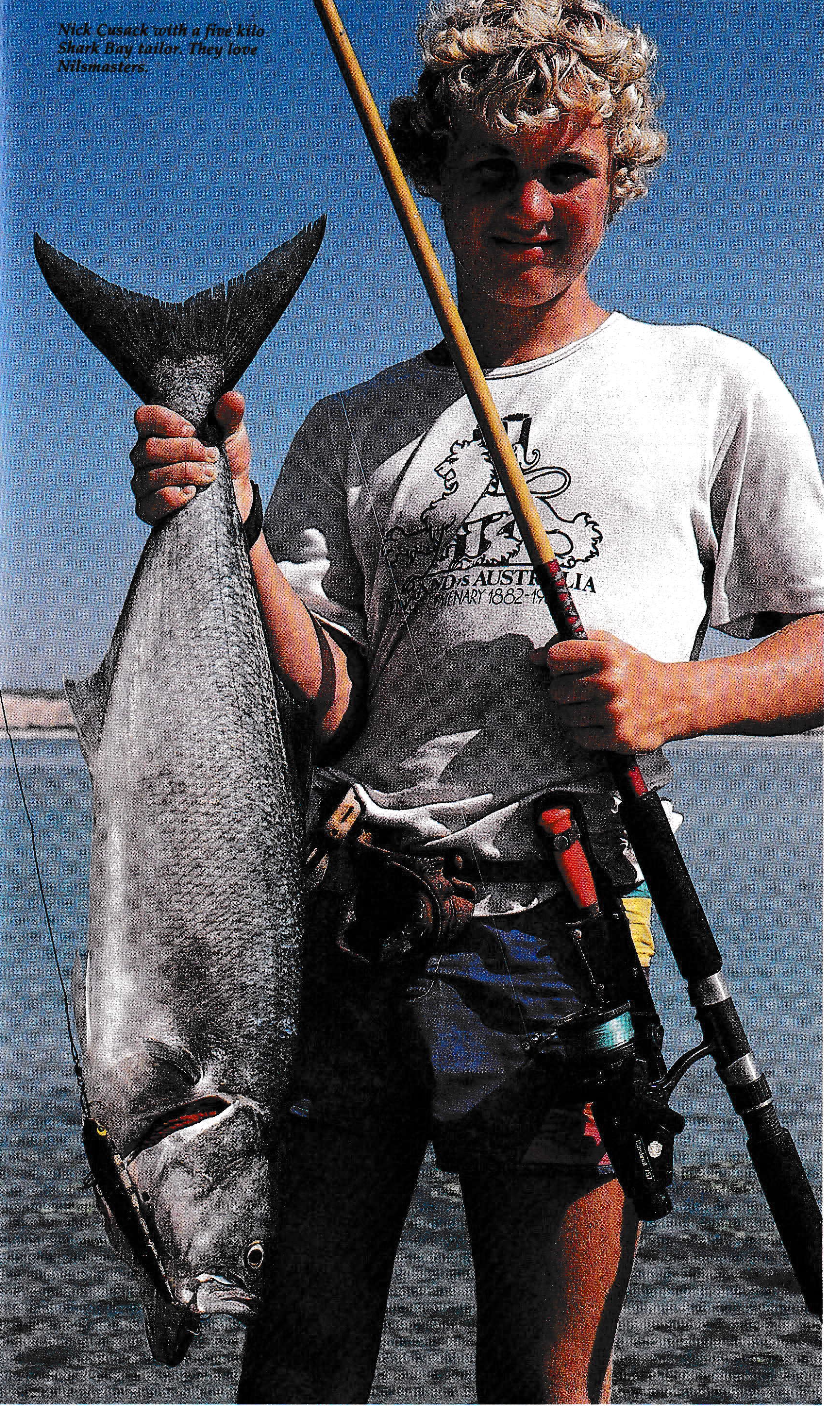
The proliferation of trevally species which occurs farther north hasn’t been apparent on my visits, but that’s not to say they don’t show up there on occasions. Marlin are a real chance from the rocks out at the Point. “Rats” up to 70 pound have already been landed and bigger beakies have been hooked.
While we were there this time a trio of small marlin rounded that most-westerly rock and gave a couple of anglers a brief thrill. One man hooked up on a Nilsmaster fished with six and a super-light rodl That didn’t last long. But the outcome could have been different if they had been fishing 20 off brutesticks.
The next big plus is that Steep Point is a great ballooning area. The prevailing southerly – or even a south-easter – sweeps balloons out into South Passage and ballooning is often the most productive way to fish – not just something to be tried when there is no spinning bite.
Arthur Drage and his group scored a host of Spaniards ballooning and Tony and I had our chances but not much luck. We missed four balloon strikes between us during one morning!
But we had one good day off the rocks there. As with Cuvier, or Hat Head – or any of the great LBG platforms – it sometimes happens that you only need one good day.
Arthur and his crew had done well early on the day we missed our balloon strikes. Mid-morning spinning elicited only repeated, frustrating follows from sharkies and Spaniards, so we resolved to be on the rocks at first light the next duy.
It was worth it. We had strike after strike from big sharkies and narrow-bars up to 20-odd. Nilsies were all the go, as usual, but Tony scored a 20 pound Spaniard on a good old no-nonsense Japanese feather jig, retrieved flat-tack on a modified Mitchell499!
Young Nick had an interesting baptism of fire on the rocks. He was broken off twice on Nilsies, had the hooks pull out of another two mackerel, and finally lost his favourite Storm minnow in a shower of spray as a big Spaniard hit it in one of those devastating rolling strikes. Ah well . . . sometimes I think he gets things too easy. Better to learn the hard way.
Clayton Howson was having a ball on sharkies and narrow-bars and I was having my moments, too. Then Tony’s balloon rod went off unattended . . . and the hookup was solid. He made short work of a 25 pound Spaniard on an Alvey and 32 pound Tortue.
Perhaps we should have turned our backs on the balloon rods the day before. Walked away and left them, or had a beer. It works, I can tell you. Twice we had to shout to Arthur’s mob over on their rock as screaming rachets signified balloon strikes on unattended rods. They landed both Spaniards too.
In the washup we counted eight sharkies and Spaniards for the morning’s work. And we Iost as many fish again, what with break-offs, hooks pulling out and gaffing misfortunes.
We were using a running cliff gaff, of course, and you can never expect 100% success with them. We gaffed the lure out of a Spaniard in the 20s and had a seal steal a good sharkie off the gaff!
But who wants more than eight mackerel in a morning?
All the lures that work at Quobba and Cuvier work at Steep Point: Nilsies, other minnows, jigs, Irons, baitfish replicas and SWF. Height is a problem, of course. You’re 30 feet above the water and metal lures tend to pop to the surface well out because of the steep angle of the line. That’s where minnows are superior, because you can work them right into the base of the cliffs. Many of our strikes and hookups came close to the rocks on minnows.
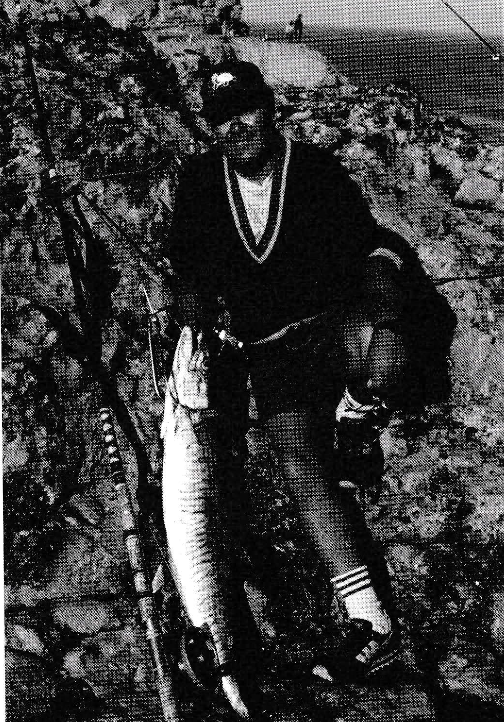
Incidentally, Nilsmaster buffs might be interested to know that our most successful colour was a pink-and-yellow version. Blue-and-yellow and brown-and-yellow also scored.
Now, what of Steep Point itself? The area, I mean, Personally, it’s not diverse enough for me. Quobba and Cuvier boast a host of prime fishable rock platforms and ballooning areas (Red Bluff), but if you don’t get a berth on the best couple of rocks at Point, you might as well not be there.
Arthur Drage’s group of six were on the westerly platform and there was a pine forest of rods (we counted 24) along the lower easterly side, facing into South Passage.
Some anglers regard this lower side as the prime LBG spot.
It goes almost without saying that there is nothing out at Steep Point – not a tree, not a blade of grass, not a flicker of shade. The wind blows 24 hours a day in the summer months, simply quartering from south-east to southerly and maintaining a constant 30-40 knots.
The Point has also been WA’s most controversial fishing location since it was “discovered” by anglers in the late ’70s.
Disgraceful littering and exorbitant hauls of fish by greedy shamateurs have been publicised prominently on many occasions, and I’m sorry to say that litter is still a problem.
The lower side stank, despite a screaming southerly, when I walked over to watch an angler playing a 10 foot hammerhead (which he later landed). The rock crevices were rececticles for coils of fishing line, fish carcasses/ lure pickets, beer cans and assorted other junk. It was a dismal scene and there’s no way I would have camped there.
Access to Steep Point has been a big problem, too. Agnew Clough, which has a salt-producing Project in the area, is not mad about unrestricted Public access out to the Point.
Litter, vandalism and a bad press about shamateur fish hauls have upset them time and again and in recent years the company has tried to place restrictions on entry to the area. In my opinion Agnew Clough has been exremely tolerant and is definitely not anti-angler; I happen to know that because a personal friend of one of its executives.
Ironically – because there’s nothing at Point, and because the journey out there is rugged up and down sandhills the place is drawing enterprising anglers like bees to a honeypot.
Those who used to enjoy camping at Quobba and Cuvier in the early days now head for the Point to do their own self-contained thing. And the emphasis is on
You must take everything. . . Power, petrol, food, drink, water, the lot. Above all, You must have a reliable, Powerful 4WD and you need to be able to drive it in heavy sand. And you should have mechanical know-how in case something goes wrong.
Take my good friend Tony, for example. Now let me say here that there’s rarely a dull moment on trips with Tony.
On this occasion tfrere were two interesting experiences. The first was a hair-raising trip across South Passage to Dirk Hartog Island to fish for jumbo tailor.
The tailor weren’t on, but the south-easter was on the way back. The Passage, which can look like a shimmering jewel on a calm day, was a cauldron of short chop and white water and we had to punch across it four-up in a 12 foot tinny.
Tony ran the gauntlet along the island to its eastern tip, which was the closest point to the Iand side (two kilometres). On the way we went ashore twice to empty the boat, which was filling up over the stern. As the tinny pounded across the passage I looked at Nick and thought, if only your mother could see you now.
We made it, of course. You always make it with Tony.
Witness the second experience, on the way back to the main road.
Tony was a trifle concerned about the last major sandhill – an obstacle he called Tin Hill because there were usually sheets of tin lying about. They bore silent testimony to Past 4WD struggles in the sand.
Tony decided to use a side track rather than tackle a head-on plunge up Tin Hill. The Bedford and trailer went down solid halfway up the track and I thought we were there for keeps.
“No worries,” said Tony. “Show you a trick I learnt in Nashos (the army). We’ll ski the trailer out.”

Stunned silence from myself and the two boys.
“First, we unhitch the trailer and I gun the van to the top of the hill. Nick, go over there and bust off a sheet of tin from that Pile (the name really meant something, after all).
“We’ll fit the tin under and over the trailer hitch. Shape it like the front of a snowplough. Then we’ll ski her up on a long length of rope.”
We did too, after a couple of abortive starts. We were able to ski her u and over that fearsome hill, and I made a mental Pledge never to doubt my old friend again You learn something every day.
lt was an added bonus on this trip in the form of some maxi-tailor on lures, but I don’t want to bore anyone with Yet another tale of Shark Bay magnum choppers.
Let’s iust say that we had a ball with fish up to six kilos. It helped to blot out all those frustrating years when double-figure tailor proved so elusive to this demented writer.
Summing up, I can see Steep Point ptoviding Cuvier-type memories over the years. Maybe not for me, but for others.
I certainly don’t see it as “the Cuvier of the 80s”. I see it as yet another great land-based game area, but with special problems – access, environmental fragility and vulnerability – an easy prey for greedy or mindless anglers.
And I certainly don’t recommend hordes rushing out there. Put bluntly, it’s a swine of a journey – particularly the last 30 kilometres out to the Point.
Put even more bluntly, the place will not survive unless it’s treated better by anglers. The littering and freezer-filling has been shameful.
On the positive side, some tips for those who do make it out there some time:
* Invest in an outsize running cliff gaff. Arthur Drage had a beauty capable of hauling really big fish up the cliff face. Visiting sportfishermen would do well to check at Mike Roennfeldt’s The Tackle Box, on West Coast Highway, Waterman. He knows what’s needed.
* Make up rod-holders with metal sPikes that can be thrust into rock crevices. They’re ideal for those (successful) unattended balloon rods.
* Take good balloon baits (gars, mullet, tailor) and use plenty of wire trace (about eight feet).
* And take plenty of rope – you might need to ski your trailer out!












